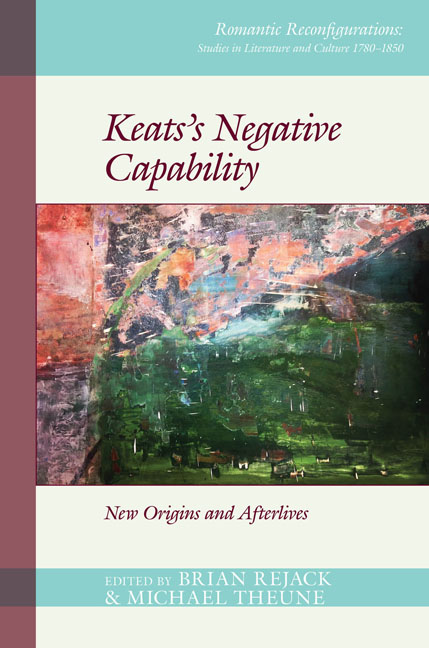Book contents
- Frontmatter
- Contents
- List of Figures
- Acknowledgments
- List of Abbreviations
- List of Contributors
- Preface
- Introduction: Disquisitions: Reading Negative Capability, 1817–2017
- Part I ‘swelling into reality’: New Contexts for Negative Capability
- Part II ‘examplified throughout’: Forms of Negatively Capable Reading
- Part III ‘pursued through Volumes’, Volume I: Negative Capability in Twentieth- and Twenty-First-Century American Poetry
- Part IV ‘pursued through Volumes’, Volume II: Adaptations, Appropriations, Mutations
- Afterword: Reading Keats's Negative Capability
- Bibliography
- Index
15 - Zen and the Art of Negative Capability
- Frontmatter
- Contents
- List of Figures
- Acknowledgments
- List of Abbreviations
- List of Contributors
- Preface
- Introduction: Disquisitions: Reading Negative Capability, 1817–2017
- Part I ‘swelling into reality’: New Contexts for Negative Capability
- Part II ‘examplified throughout’: Forms of Negatively Capable Reading
- Part III ‘pursued through Volumes’, Volume I: Negative Capability in Twentieth- and Twenty-First-Century American Poetry
- Part IV ‘pursued through Volumes’, Volume II: Adaptations, Appropriations, Mutations
- Afterword: Reading Keats's Negative Capability
- Bibliography
- Index
Summary
Zen has a similar style: contradictoriness, crazy wisdom, based on the fact that things both exist and don't exist at the same time—relative and absolute truths. You don't need to drill a hole in your head in order to get enlightened. You can hold several ideas in your mind that are contradictory without freaking out, Keats’s negative capability. Sure, you can reach out to ‘fact and reason’, as long as it isn't an aggressive insistence, irritability motivating the reaching for fact. That's my opinion.
What can't Negative Capability attach itself to? It turns out: not much.
This essay explores the uses of negative capability and other ‘Keatsian’ ideas in the discourse of twentieth- and twenty-first-century Buddhist modernism. The term ‘Buddhist modernism’ indicates, as David McMahan explains, ‘a modern hybrid tradition with roots in the European Enlightenment no less than the Buddha's enlightenment, in Romanticism and transcendentalism as much as the Pali canon, and in the clash of Asian cultures and colonial powers as much as in mindfulness and meditation’. Although a longstanding scholarly consensus holds that ‘Buddhism’ is a textual invention of Western imperialism that reached its height in the nineteenth century and that its canon was, in essence, created by Western scholars who translated and interpreted Asian texts in order to construct an ‘authentic’ or ‘classical’ Buddhism, usually in ways that minimized or rejected the experience of Buddhist practitioners in Asia, Buddhist modernism recognizes the ‘agency of Asian Buddhists as cocreators of modernist versions of their traditions’. Within this broad context of exchange and hybridity, I am specifically interested in the way that the ‘Romantic’ concept of negative capability functions in cross-cultural discussions of Zen principles, enabling the multi-directional dynamic of ‘surprising recognition’, a term I borrow from Eve Kosofsky Sedgwick. The resonance between negative capability and Buddhist ideas such as emptiness and the dropping away of self makes sense on a kind of affective level, ‘[a]s if’—Sedgwick suggests—‘the template of truth is already there inside the listener, its own lineaments clarified by the encounter with a teaching that it can then apprehend as “true”’.
- Type
- Chapter
- Information
- Keats's Negative CapabilityNew Origins and Afterlives, pp. 232 - 244Publisher: Liverpool University PressPrint publication year: 2019

